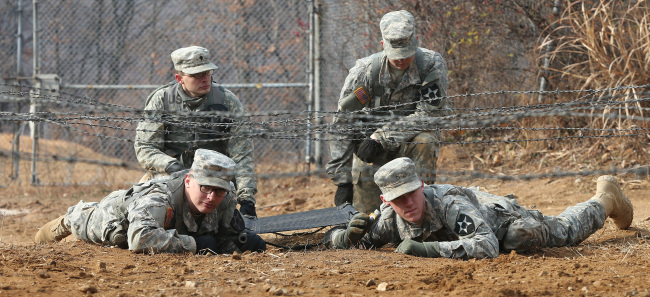The U.S. State Department said Sunday that in accordance with its security commitment to South Korea, U.S. troops in Japan would be automatically deployed to the Korean Peninsula in the event of a conflict, without prior consultation with Tokyo.
Yonhap News agency reported that the State Department responded to its question, saying that Washington would not have prior consultations over an emergency plan, and that the U.S. is fully ready to implement its obligations under the mutual defense treaty with Seoul.
The statement eased rising concerns here that in light of worsening bilateral ties with Seoul, Tokyo could impede the rapid deployment of marines from Japan to South Korea in the event of an attack by North Korea.
Yonhap News agency reported that the State Department responded to its question, saying that Washington would not have prior consultations over an emergency plan, and that the U.S. is fully ready to implement its obligations under the mutual defense treaty with Seoul.
The statement eased rising concerns here that in light of worsening bilateral ties with Seoul, Tokyo could impede the rapid deployment of marines from Japan to South Korea in the event of an attack by North Korea.

The concerns flared up after Japanese Prime Minister Shinzo Abe reportedly said in July that under the security arrangement with the U.S., U.S. Forces Japan is required to secure Tokyo’s understanding should it want to send its marines to the peninsula in a contingency.
The concerns have been amplified as some U.S. and Japanese scholars have also concurred with Abe’s statement on the deployment of Japan-based U.S. troops to regional conflicts.
Under the U.S.-Japan mutual defense treaty first signed in 1952 and revised in 1960, the U.S. currently stations about 50,000 troops in Japan, more than half of whom are based in Okinawa due to its strategic location that enables rapid deployment to the Korean Peninsula, the Taiwan Straits and other areas in the region.
There are seven rear bases in Japan of the U.N. Command that will help support South Korea in case of a war on the peninsula. The rear bases that would support the wartime deployment of U.S. troops to the peninsula include Camp Zama near Tokyo; Kadena Air Base, the hub of America’s airpower in the Asia Pacific; and Yokosuka Naval Base, the largest U.S. Navy installations in the Western Pacific.
The U.S.-led UNC is a unified command structure for multi-national military forces, which was established after the U.N. adopted its Security Council Resolution 84 on July 7, 1950.
Amid escalating diplomatic tensions between Seoul and Tokyo over territorial and historical feuds, fears have spread that Japan could become uncooperative about the U.S.’ mobilization of its troops in Japan for peninsular defense.
Under OPLAN 5027, a joint war plan, the U.S. is dispatch its 690,000 troops to the peninsula and mobilize 160 military vessels and 2,500 aircraft within 90 days of the outbreak of a war. Most of the troops are to come from Okinawa, Guam and the U.S. Pacific Command headquartered in Hawaii.
By Song Sang-ho (sshluck@heraldcorp.com)
-
Articles by Korea Herald




![[Herald Interview] 'Amid aging population, Korea to invite more young professionals from overseas'](http://res.heraldm.com/phpwas/restmb_idxmake.php?idx=644&simg=/content/image/2024/04/24/20240424050844_0.jpg&u=20240424200058)












![[KH Explains] Korean shipbuilding stocks rally: Real growth or bubble?](http://res.heraldm.com/phpwas/restmb_idxmake.php?idx=652&simg=/content/image/2024/04/25/20240425050656_0.jpg&u=)

